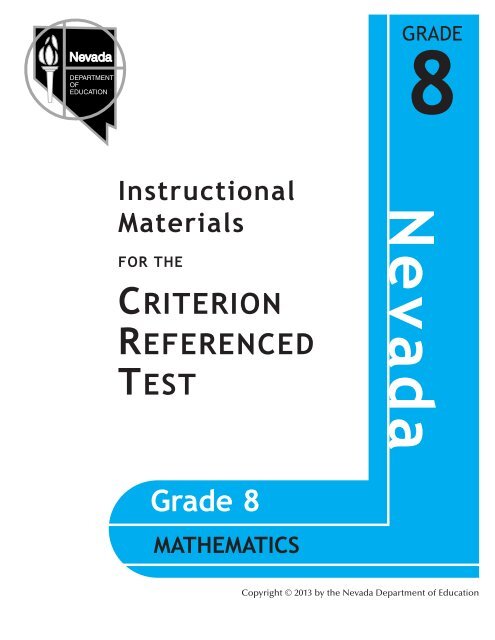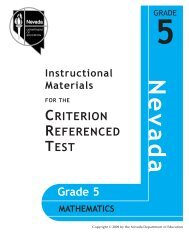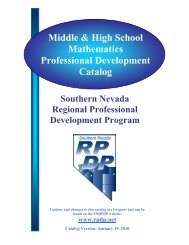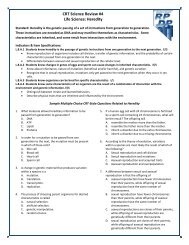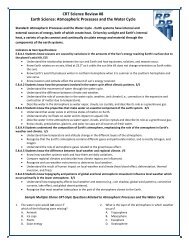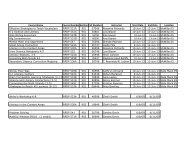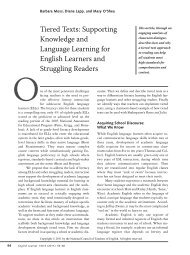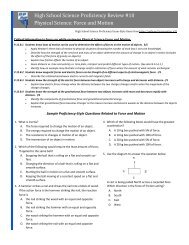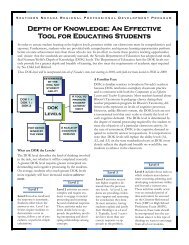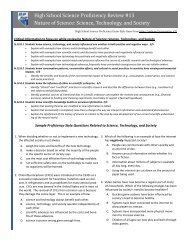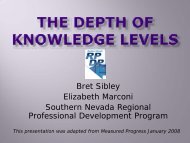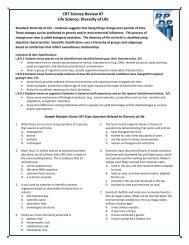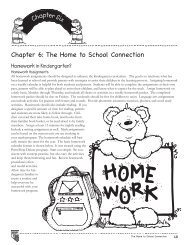Grade 8 Math Instructional Materials 2013.pdf - RPDP
Grade 8 Math Instructional Materials 2013.pdf - RPDP
Grade 8 Math Instructional Materials 2013.pdf - RPDP
Create successful ePaper yourself
Turn your PDF publications into a flip-book with our unique Google optimized e-Paper software.
Nevada<br />
DEPARTMENT<br />
OF<br />
EDUCATION<br />
GRADE<br />
8<br />
<strong>Instructional</strong><br />
<strong>Materials</strong><br />
for the<br />
CRITERION<br />
REFERENCED<br />
TEST<br />
Nevada<br />
<strong>Grade</strong> 8<br />
MATHEMATICS<br />
Copyright © 2013 by the Nevada Department of Education
JAMES W. GUTHRIE<br />
Superintendent of<br />
Public Instruction<br />
RORIE FITZPATRICK<br />
Deputy Superintendent<br />
<strong>Instructional</strong>, Research, and<br />
Evaluative Services<br />
STATE OF NEVADA<br />
TEACHER LICENSURE<br />
SOUTHERN NEVADA OFFICE<br />
9890 S. Maryland Parkway<br />
Suite 221<br />
Las Vegas, Nevada 89183<br />
(702) 486-6458<br />
Fax: (702) 486-6450<br />
DEBORAH CUNNINGHAM<br />
Deputy Superintendent<br />
Administrative and<br />
Fiscal Services<br />
Dear Educators,<br />
DEPARTMENT OF EDUCATION<br />
700 E. Fifth Street<br />
Carson City, Nevada 89701-5096<br />
(775) 687-9217 · Fax: (775) 687-9101<br />
www.doe.nv.gov<br />
SATELLITE OFFICE<br />
ADDRESSES/MAPS<br />
http://www.doe.nv.gov<br />
The following materials, developed as a collaborative effort between the Nevada Department of Education and<br />
WestEd, a nonprofit research, development, and service agency, are designed to be used as part of a guided<br />
instructional activity to support student performance on items aligned to the Common Core Standards.<br />
We have provided p-values (the proportion of students who got the item correct) for the multiple-choice items<br />
that were field tested in the 2011-2012 administration. The p-values indicate how students performed on the<br />
items. In addition, we are providing the percentage of students selecting each response option. The p-values,<br />
combined with the item-level percentages by response option, provide valuable data to the field as to what types<br />
of errors students are making. For mathematics, no p-value is reported if that item did not appear on the field<br />
test. In mathematics, some field test items have been used as a model to mirror the content being assessed and<br />
therefore the p-values are based on the field test version of the item and not the actual item as it appears in these<br />
materials. These items are indicated by an asterisk. To further understanding of constructed-response items,<br />
scoring guides and annotated student examples have been included.<br />
While these materials can provide students with practice in answering assessment items, we believe it is critical<br />
that these materials be used to help students understand the elements of the state assessment and guide them in<br />
the use of effective strategies that will support their ability to comprehend and take a variety of assessments. If<br />
you choose, however, to use these support documents solely as a practice activity, we highly recommend that<br />
you go back over each item with students and investigate each response to better understand their knowledge of<br />
the assessment.<br />
Vocabulary Knowledge<br />
The Nevada Department of Education believes that students are not thoroughly being taught the content<br />
vocabulary of the Nevada <strong>Math</strong>ematics Content Standards. For example, equation, expression, coordinate,<br />
function, histogram, analyze, and justify are terms used in the assessments at grade-appropriate levels.<br />
Students in Nevada, therefore, must have repeated experiences with speaking, listening, reading, and writing<br />
the vocabulary of the standards. Students should be able to use the vocabulary of the standards when they are<br />
engaged in classroom discussion, read them in assessments, and effectively use the vocabulary in their writing.<br />
Types of Questions and Support Documents<br />
The mathematics assessment includes two types of questions—multiple-choice questions for all grades (3 – 8<br />
and high school) and constructed-response questions for grades 4 – 8.<br />
Copyright © 2013 by the Nevada Department of Education<br />
Page i
To help prepare students for constructed-response questions, we have provided you with:<br />
1. the student checklist (included in the student test booklet at grades 4 and 5)<br />
2. the general student rubric (included in the student test booklet at grades 6 – 8)<br />
3. item-specific rubrics<br />
4. annotated student work<br />
With the use of these materials, students can become familiar with the different types of questions used on the<br />
state and future assessments. They can learn to use the checklist or rubric to determine if they have answered<br />
the constructed-response questions completely. Familiarity with the tools provided as part of the assessment and<br />
the vocabulary of the standards can result in less anxiety on the part of students and teachers. (Please note that<br />
the student checklist and general rubric can be on the walls of your classroom throughout the school year. As<br />
you assign constructed-response questions, students can use these tools as they develop their answers.)<br />
Depth of Knowledge (DOK) Levels - In addition to measuring a broad spectrum of mathematics content<br />
domains, the types of questions included in these instructional materials allow for the assessment of different<br />
levels of cognitive complexity. The Nevada Proficiency Examination Program in mathematics includes items<br />
to assess three Depth of Knowledge levels. These DOK levels are based on descriptions developed by Dr.<br />
Norman Webb and adapted for Nevada's mathematics assessments. We suggest that you engage students in<br />
question writing so they not only can recognize these levels of complexity, but can begin to formulate them as<br />
well. The following are the three DOK levels used on Nevada’s mathematics assessments:<br />
DOK Level 1: Recall - Level 1 requires the recall of facts or use of basic skills. A level 1 item consists of<br />
literal recall from text, paraphrasing, or simple understanding of a single word or phrase. A level 1 item<br />
may require a simple connection between sentences, which may be considered a very basic inference.<br />
DOK Level 2: Use of Concepts and Skills - Level 2 requires comprehension and mental processing of<br />
text or portions of text. A level 2 item includes the engagement of some mental processing beyond<br />
recalling or reproducing a response. A level 2 item requires the application of skills and concepts. Some<br />
important concepts are covered but not in a deeply complex way.<br />
DOK Level 3: Strategic Thinking and Problem Solving - Level 3 requires abstract reasoning, critical<br />
thinking, and/or the application of abstract concepts to new situations.<br />
We hope that interaction with these instructional support materials will lead to lowered anxiety and better<br />
understanding of the assessment task that is being presented to students. If you have questions about the<br />
mathematics materials or how to embed this information into your curriculum, please contact Tracy Gruber at<br />
tgruber@doe.nv.gov.<br />
Cindy Sharp<br />
Nevada Department of Education<br />
Copyright © 2013 by the Nevada Department of Education<br />
Page ii
Name:<br />
<strong>Math</strong>ematics<br />
<strong>Grade</strong> 8<br />
This booklet contains mathematics questions for you to answer. There are two types of questions in this<br />
booklet. For the multiple-choice questions, you will be given four answer choices—A, B, C, and D. You are<br />
to choose the correct answer from the four choices. Each question has only one right answer. The writtenresponse<br />
question requires you to give a written response to a question as indicated in the booklet. You<br />
will be given a separate sheet of paper to answer this question.<br />
You may use the rubric below to help you do a good job when you are answering the written-response<br />
question.<br />
Score<br />
Full Credit<br />
Expectation<br />
Your response addresses all parts of the question clearly and correctly. You use<br />
and label the proper math terms in your answer.<br />
Your response shows all the steps you took to solve the problem.<br />
Partial Credit<br />
Your response addresses most parts of the question correctly.<br />
Your response does not show all of your work or does not completely<br />
explain the steps you took to solve the problem.<br />
Minimal Credit<br />
Your response addresses only one part of the question correctly and explains<br />
the steps you took to solve that one part. In answering the remaining parts of<br />
the question, your response is incomplete or incorrect.<br />
Your response does not show all of your work or does not explain all of the<br />
steps you took to solve the problem.<br />
No Credit<br />
Your response is incorrect.<br />
Copyright © 2013 by the Nevada Department of Education<br />
Page 1
<strong>Grade</strong> 8 <strong>Math</strong>ematics<br />
<strong>Instructional</strong> <strong>Materials</strong><br />
■ 1 The decimal form of each of four different<br />
numbers contains an infinite number of<br />
digits. Stacy writes only the first seven<br />
digits of each number, without rounding.<br />
Which of these numbers is most likely to<br />
be irrational?<br />
■ 3 3<br />
What is 216<br />
A 6<br />
B 24<br />
C 36<br />
D 72<br />
?<br />
A 4.090909<br />
B 4.125000<br />
C 4.222222<br />
D 4.898979<br />
■ 2 Look at the values shown below.<br />
π 2 38<br />
99<br />
7<br />
3 15<br />
■ 4 Which is closest to the sum of 1.128 × 10 8<br />
and 7.282 × 10 7 ?<br />
A 1.86 × 10 7<br />
B 8.41 × 10 7<br />
C 1.86 × 10 8<br />
D 8.41 × 10 8<br />
What is the order of the values from<br />
greatest to least?<br />
A<br />
B<br />
99<br />
7<br />
99<br />
7<br />
C 3 15 38<br />
D 3 15<br />
38 3 15<br />
2<br />
π<br />
2<br />
3 15 π 38<br />
99<br />
7<br />
2<br />
π<br />
99<br />
7<br />
2<br />
π<br />
38<br />
Copyright © 2013 by the Nevada Department of Education Page 2<br />
Go On
<strong>Grade</strong> 8 <strong>Math</strong>ematics<br />
<strong>Instructional</strong> <strong>Materials</strong><br />
■ 5 Look at the equation below.<br />
3<br />
10 y − 8 7 6 4 1 2<br />
y + = + y −<br />
2<br />
What is the solution of the equation?<br />
A y = 2 7 9<br />
B y = 21<br />
29<br />
C y = -1 2 7<br />
D y = -2 1 5<br />
■ 6 Which equation does not describe a<br />
linear function?<br />
A y = 7<br />
2<br />
B y = 2x<br />
− 5<br />
C 2y<br />
= 3x<br />
− 9<br />
D 4x<br />
− 6y<br />
= 13<br />
■ 7 Polygon MNPQ is shown on the coordinate<br />
plane below. A dilation with center of<br />
dilation at the origin will be performed on<br />
the polygon.<br />
M<br />
-16 -12<br />
P<br />
-8<br />
Q<br />
16<br />
12<br />
8<br />
4<br />
-4<br />
-4<br />
-8<br />
-12<br />
-16<br />
y<br />
4 8 12 16<br />
The location of vertex M after the dilation<br />
is (-8, 6) . What is the location of vertex N<br />
after the dilation?<br />
N<br />
x<br />
A (0, 4)<br />
B (1, 2)<br />
C (4, 5)<br />
D (16, 4)<br />
Copyright © 2013 by the Nevada Department of Education Page 3<br />
Go On
<strong>Grade</strong> 8 <strong>Math</strong>ematics<br />
<strong>Instructional</strong> <strong>Materials</strong><br />
■ 8 Jenny used three squares to make a design. She labeled each square with its area. Jenny drew the<br />
squares so that triangle ABC was formed, as shown in the diagram below.<br />
A<br />
169 cm 2<br />
25 cm 2 144 cm 2<br />
C<br />
B<br />
Jenny uses the converse of the Pythagorean theorem to write a statement about triangle ABC .<br />
Which statement could Jenny have written?<br />
A Since triangle ABC is a right triangle, the sum of the length of side AC and the length of side CB<br />
is equal to the length of side AB .<br />
B Since triangle ABC is a right triangle, the sum of the area of the square with side AC and the area<br />
of the square with side CB is equal to the area of the square with side AB .<br />
C Since the sum of the length of side AC and the length of side CB is equal to the length of<br />
side AB, the longest side of triangle ABC, then triangle ABC is a right triangle.<br />
D Since the sum of the area of the square with side AC and the area of the square with side CB is<br />
equal to the area of the square with side AB, the longest side of triangle ABC, then triangle ABC<br />
is a right triangle.<br />
Copyright © 2013 by the Nevada Department of Education Page 4<br />
Go On
<strong>Grade</strong> 8 <strong>Math</strong>ematics<br />
■ 9 A rectangular prism is shown in the<br />
diagram below.<br />
N<br />
R<br />
24 mm<br />
J<br />
P<br />
M<br />
Q<br />
32 mm<br />
K<br />
9 mm<br />
L<br />
What is the length of the line segment that<br />
extends between vertex K and vertex R ?<br />
■<br />
<strong>Instructional</strong> <strong>Materials</strong><br />
10<br />
The locations of point A and point B on<br />
a coordinate plane are described by the<br />
ordered pairs listed below.<br />
A(-3, 5) B(2, -1)<br />
What is the shortest distance between<br />
point A and point B ?<br />
A<br />
B<br />
C<br />
D<br />
11 units<br />
37 units<br />
61 units<br />
73 units<br />
A 65 mm<br />
B 40 mm<br />
C 41 mm<br />
D 6912 mm<br />
Copyright © 2013 by the Nevada Department of Education Page 5<br />
Go On
<strong>Grade</strong> 8 <strong>Math</strong>ematics<br />
<strong>Instructional</strong> <strong>Materials</strong><br />
Write your answer to Question 11 on a separate sheet of paper. Be sure to answer<br />
Parts A and B.<br />
■<br />
A bake shop makes a cake shaped like a hemisphere, as pictured below.<br />
11<br />
6 in<br />
cake<br />
A What is the volume, in cubic inches, of the cake? Leave your answer written in terms of π .<br />
Show your work.<br />
B The bake shop also makes a cake shaped like a cylinder. This cake has the same volume and<br />
radius as the cake from Part A. What is the height, in inches, of the cake shaped like a cylinder?<br />
Show your work or explain your thinking<br />
Copyright © 2013 by the Nevada Department of Education Page 6<br />
Go On
<strong>Grade</strong> 8 <strong>Math</strong>ematics<br />
<strong>Instructional</strong> <strong>Materials</strong><br />
You may want to go back and check your answers or answer questions<br />
you did not complete.<br />
Copyright © 2013 by the Nevada Department of Education Page 7
Nevada<br />
DEPARTMENT<br />
OF<br />
EDUCATION<br />
GRADE<br />
8<br />
Appendix I<br />
Scoring<br />
Support<br />
<strong>Materials</strong><br />
Nevada<br />
<strong>Grade</strong> 8<br />
MATHEMATICS<br />
Copyright © 2013 by the Nevada Department of Education<br />
Page 8
Item<br />
Number<br />
Correct Answers for Multiple-Choice Items<br />
Item Level Data<br />
Percentage of Students Selecting<br />
a Given Response<br />
Strand DOK P-value A B C D<br />
1 1 1 0.29 18% 18% 35% 29% ✓<br />
2* 1 2 0.23 27% 23% ✓ 17% 33%<br />
3* 1 1 0.23 23% ✓ 31% 15% 31%<br />
4 1 1 0.25 10% 24% 25% ✓ 41%<br />
5* 2 1 0.32 21% 24% 23% 32% ✓<br />
6 2 1 0.21 47% 21% ✓ 13% 20%<br />
7* 4 2 0.22 13% 20% 22% ✓ 45%<br />
8 4 2 0.23 23% 32% 22% 23% ✓<br />
9* 4 2 0.26 21% 33% 26% ✓ 20%<br />
10 4 2 0.22 46% 26% 22% ✓ 6%<br />
P-value is the proportion of students who got<br />
the item correct<br />
✓ = Correct Answer<br />
*This is an item that was developed for these<br />
<strong>Instructional</strong> <strong>Materials</strong>, and it mirrors content<br />
assessed from an item field tested in the<br />
2011-2012 test administration. The p-value<br />
and percentages reported here are based on<br />
the p-value and percentages of the item from<br />
the 2011-2012 field test.<br />
Detailed objectives for Content Standards and Depth of Knowledge (DOK) descriptions<br />
can be found on the Nevada Department of Education web site.<br />
Copyright © 2013 by the Nevada Department of Education Page 9
Nevada 8 2011-12<br />
<strong>Math</strong>ematics<br />
Version 6 #50 I-Ref #: WE: Y12_MA2918 Rpt Cat(s): NO NV MATCH<br />
Date: 1/24/12<br />
CCCS: 8.G.9<br />
Score<br />
Description<br />
3 Student scores 3 points.<br />
2 Student scores 2–2.5 points.<br />
1 Student scores 0.5–1.5 points.<br />
0 Student’s response provides insufficient evidence of appropriate skills or<br />
knowledge to successfully accomplish the task.<br />
Blank No student response.<br />
Score Points<br />
Part A: score 1.5 points correct answer with correct and complete work<br />
OR<br />
score 1.0 point<br />
OR<br />
score 0.5 point<br />
correct answer with incomplete work<br />
OR<br />
incorrect answer due to calculation error (work must be<br />
shown)<br />
correct answer with no work<br />
OR<br />
some correct procedure<br />
Part B: score 1.5 points correct answer (based on answer to Part A) with correct<br />
and complete work or explanation<br />
OR<br />
score 1.0 point<br />
OR<br />
score 0.5 point<br />
correct answer (based on answer to Part A) with<br />
incomplete work or explanation<br />
OR<br />
incorrect answer due to calculation error (work must be<br />
shown)<br />
correct answer (based on answer to Part A) with no work<br />
or explanation<br />
OR<br />
some correct procedure<br />
OR<br />
vague explanation only<br />
Copyright © 2013 by the Nevada Department of Education<br />
Page 10
Nevada 8 2011-12<br />
<strong>Math</strong>ematics<br />
Version 6 #50 I-Ref #: WE: Y12_MA2918 Rpt Cat(s): NO NV MATCH<br />
Date: 1/24/12<br />
CCCS: 8.G.9<br />
Correct Answers<br />
Part A: 144π (cubic inches) 1 ⎛ 4<br />
V = πr<br />
2 ⎝ 3<br />
2 3<br />
V = π( 6 )<br />
⎞<br />
⎠<br />
3<br />
2<br />
V = π( 216)<br />
3<br />
V = 144π<br />
or equivalent work<br />
3<br />
Part B:<br />
4 (inches)<br />
2<br />
V = πr h<br />
( )<br />
144π = π 6 h<br />
144 = 36h<br />
4 = h<br />
or equivalent work<br />
OR<br />
2<br />
Set the two volumes equal to each other and then solve for the<br />
height. The height of the cake is 4 inches since 144 ÷ 36 = 4 .<br />
Copyright © 2013 by the Nevada Department of Education<br />
Page 11
Nevada<br />
DEPARTMENT<br />
OF<br />
EDUCATION<br />
Student<br />
Response<br />
Examples by<br />
Score Point<br />
Copyright © 2013 by the Nevada Department of Education<br />
Page 12
Contract: 1378 1 Booklet: 1850003573 Page: 1 of 1 Score: 3 RespCode: MA06050<br />
Annotation: a-1.5 b-1.5 = 3.0 points<br />
Score Point: 3<br />
The response to Part A includes a correct answer Anchor and complete work (1.5). The<br />
Page 1<br />
response to Part B includes a correct answer and complete work/explanation (1.5).<br />
Copyright © 2013 by the Nevada Department of Education<br />
Page 13
Contract: 1378 1 Booklet: 1850001574 Page: 1 of 1 Score: 3 RespCode: MA06050<br />
Annotation: a-1.5 b-1.5 = 3.0 points<br />
Score Point: 3<br />
The response to Part A includes a correct answer<br />
Extras<br />
and complete work (1.5). The<br />
Page 4<br />
response to Part B includes a correct answer and complete work/explanation (1.5).<br />
Copyright © 2013 by the Nevada Department of Education<br />
Page 14
Annotation: a-1.0 b-1.5 = 2.5 points; Part A has the correct strategy with a computation error when dividing 432 by 3). Part<br />
B is correct with work based on Part A.<br />
Score Point: 2<br />
Anchor<br />
The response to Part A includes an incorrect Page answer 3 due to a calculation error (1.0).<br />
The response to Part B includes a correct answer and complete work (based on<br />
answer to Part A) (1.5).<br />
Copyright © 2013 by the Nevada Department of Education<br />
Page 15
Annotation: a-1.5 b-.5 = 2.0 points; Part A is correct with work. Part B has started the strategy correctly but subtracts 36<br />
from 144 rather than dividing 144 by 36.<br />
Score Point: 2<br />
Anchor<br />
The response to Part A includes a correct answer Page 4 and complete work (1.5).<br />
The response to Part B includes an incorrect answer but shows some correct<br />
procedure (0.5).<br />
Copyright © 2013 by the Nevada Department of Education<br />
Page 16
Annotation: a-0 b-.5 = .5 points; Part A is incorrect. Part B has some correct procedure. The student set up the problem<br />
correctly but then divides by 3 which is incorrect.<br />
Score Point: 1<br />
Anchor<br />
Page 5<br />
The response to Part A includes an incorrect answer (0). The response to Part B<br />
includes an incorrect answer but shows some correct procedure (0.5).<br />
Copyright © 2013 by the Nevada Department of Education<br />
Page 17
Contract: 1378 1 Booklet: 1850015123 Page: 1 of 1 Score: 1 RespCode: MA06050<br />
Annotation: a-1.5 b-0 = 1.5 points; Part A is correct (not left if terms of pi). Part B is incorrect.<br />
Score Point: 1<br />
The response to Part A includes a correct answer and complete work (1.5). No<br />
Anchor<br />
deduction was made for an answer not left in Page terms 6 of pi. The response to Part B<br />
includes an incorrect answer (0).<br />
Copyright © 2013 by the Nevada Department of Education<br />
Page 18
Nevada<br />
DEPARTMENT<br />
OF<br />
EDUCATION<br />
GRADE<br />
8<br />
Appendix II<br />
Administrative<br />
Support<br />
<strong>Materials</strong><br />
Nevada<br />
<strong>Grade</strong> 8<br />
MATHEMATICS<br />
Copyright © 2013 by the Nevada Department of Education<br />
Page 19
Name:<br />
Answer Document<br />
<strong>Math</strong>ematics<br />
1.<br />
2.<br />
3.<br />
4.<br />
5.<br />
6.<br />
7.<br />
8.<br />
9.<br />
10.<br />
A<br />
A<br />
A<br />
A<br />
A<br />
A<br />
A<br />
A<br />
A<br />
B<br />
B<br />
B<br />
B<br />
B<br />
B<br />
B<br />
B<br />
B<br />
C<br />
C<br />
C<br />
C<br />
C<br />
C<br />
C<br />
C<br />
C<br />
D<br />
D<br />
D<br />
D<br />
D<br />
D<br />
D<br />
D<br />
D<br />
A B C D<br />
11. Written Response<br />
Copyright © 2013 by the Nevada Department of Education<br />
Page 20
WRITTEN RESPONSE<br />
MATHEMATICS<br />
D<br />
O<br />
N<br />
O<br />
T<br />
W<br />
R<br />
I<br />
T<br />
E<br />
I<br />
N<br />
T<br />
H<br />
I<br />
S<br />
S<br />
P<br />
A<br />
C<br />
E<br />
DO NOT WRITE IN THIS SPACE<br />
STOP<br />
Copyright © 2013 by the Nevada Department of Education Page 21
WRITTEN RESPONSE<br />
MATHEMATICS<br />
D<br />
O<br />
N<br />
O<br />
T<br />
W<br />
R<br />
I<br />
T<br />
E<br />
I<br />
N<br />
T<br />
H<br />
I<br />
S<br />
S<br />
P<br />
A<br />
C<br />
E<br />
DO NOT WRITE IN THIS SPACE<br />
STOP<br />
Copyright © 2013 by the Nevada Department of Education Page 22
WRITTEN RESPONSE<br />
MATHEMATICS<br />
D<br />
O<br />
N<br />
O<br />
T<br />
W<br />
R<br />
I<br />
T<br />
E<br />
I<br />
N<br />
T<br />
H<br />
I<br />
S<br />
S<br />
P<br />
A<br />
C<br />
E<br />
DO NOT WRITE IN THIS SPACE<br />
STOP<br />
Copyright © 2013 by the Nevada Department of Education Page 23
WRITTEN RESPONSE<br />
MATHEMATICS<br />
D<br />
O<br />
N<br />
O<br />
T<br />
W<br />
R<br />
I<br />
T<br />
E<br />
I<br />
N<br />
T<br />
H<br />
I<br />
S<br />
S<br />
P<br />
A<br />
C<br />
E<br />
DO NOT WRITE IN THIS SPACE<br />
STOP<br />
Copyright © 2013 by the Nevada Department of Education Page 24
Nevada Department of Education<br />
Nevada<br />
DEPARTMENT<br />
OF<br />
EDUCATION<br />
James W. Guthrie<br />
Superintendent of Public Instruction<br />
Office of Assessment, Program Accountability, and Curriculum<br />
775-687-9188<br />
GRADE<br />
8<br />
CRT • <strong>Instructional</strong> <strong>Materials</strong>


